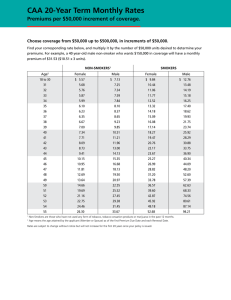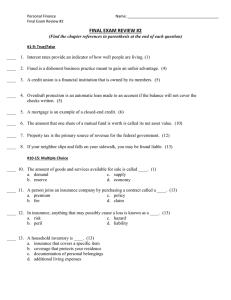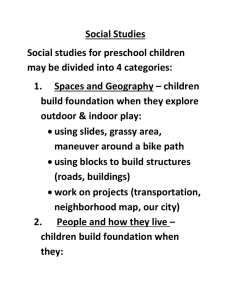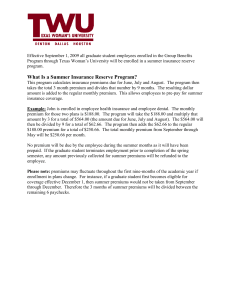FLOOR AREA RATIO PREMIUM APPLICATION
advertisement
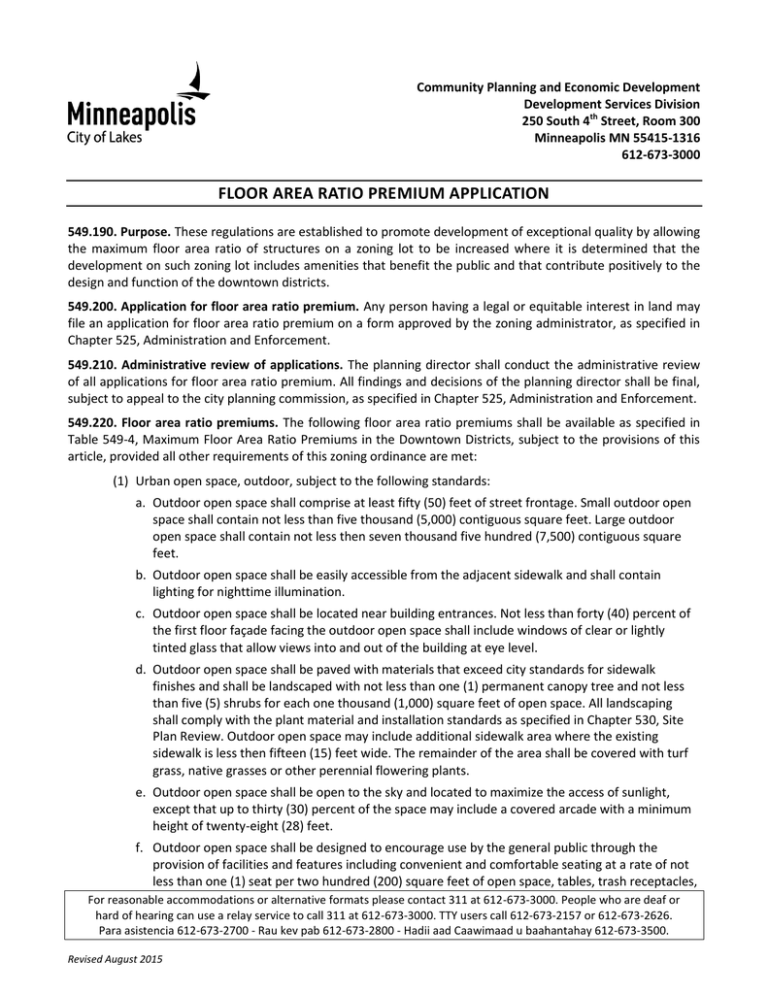
Community Planning and Economic Development Development Services Division 250 South 4th Street, Room 300 Minneapolis MN 55415-1316 612-673-3000 FLOOR AREA RATIO PREMIUM APPLICATION 549.190. Purpose. These regulations are established to promote development of exceptional quality by allowing the maximum floor area ratio of structures on a zoning lot to be increased where it is determined that the development on such zoning lot includes amenities that benefit the public and that contribute positively to the design and function of the downtown districts. 549.200. Application for floor area ratio premium. Any person having a legal or equitable interest in land may file an application for floor area ratio premium on a form approved by the zoning administrator, as specified in Chapter 525, Administration and Enforcement. 549.210. Administrative review of applications. The planning director shall conduct the administrative review of all applications for floor area ratio premium. All findings and decisions of the planning director shall be final, subject to appeal to the city planning commission, as specified in Chapter 525, Administration and Enforcement. 549.220. Floor area ratio premiums. The following floor area ratio premiums shall be available as specified in Table 549-4, Maximum Floor Area Ratio Premiums in the Downtown Districts, subject to the provisions of this article, provided all other requirements of this zoning ordinance are met: (1) Urban open space, outdoor, subject to the following standards: a. Outdoor open space shall comprise at least fifty (50) feet of street frontage. Small outdoor open space shall contain not less than five thousand (5,000) contiguous square feet. Large outdoor open space shall contain not less then seven thousand five hundred (7,500) contiguous square feet. b. Outdoor open space shall be easily accessible from the adjacent sidewalk and shall contain lighting for nighttime illumination. c. Outdoor open space shall be located near building entrances. Not less than forty (40) percent of the first floor façade facing the outdoor open space shall include windows of clear or lightly tinted glass that allow views into and out of the building at eye level. d. Outdoor open space shall be paved with materials that exceed city standards for sidewalk finishes and shall be landscaped with not less than one (1) permanent canopy tree and not less than five (5) shrubs for each one thousand (1,000) square feet of open space. All landscaping shall comply with the plant material and installation standards as specified in Chapter 530, Site Plan Review. Outdoor open space may include additional sidewalk area where the existing sidewalk is less then fifteen (15) feet wide. The remainder of the area shall be covered with turf grass, native grasses or other perennial flowering plants. e. Outdoor open space shall be open to the sky and located to maximize the access of sunlight, except that up to thirty (30) percent of the space may include a covered arcade with a minimum height of twenty-eight (28) feet. f. Outdoor open space shall be designed to encourage use by the general public through the provision of facilities and features including convenient and comfortable seating at a rate of not less than one (1) seat per two hundred (200) square feet of open space, tables, trash receptacles, For reasonable accommodations or alternative formats please contact 311 at 612-673-3000. People who are deaf or hard of hearing can use a relay service to call 311 at 612-673-3000. TTY users call 612-673-2157 or 612-673-2626. Para asistencia 612-673-2700 - Rau kev pab 612-673-2800 - Hadii aad Caawimaad u baahantahay 612-673-3500. Revised August 2015 plants, water features, and areas for public entertainment or public display of art or cultural exhibits g. Outdoor open space may contain tables and facilities for food service, but a majority of the space shall be available for general public use without charge. h. The outdoor open space shall be open to the general public at least during the normal business hours of the surrounding area. i. The outdoor open space shall be maintained in good order for the life of the principal structure. (2) Urban open space, indoor, subject to the following standards: a. Indoor open space shall be located at street level and shall be not more than three (3) feet above or below the level of the sidewalk. Small indoor open space shall contain not less than five thousand (5,000) contiguous square feet. Large indoor open space shall contain not less then seven thousand five hundred (7,500) contiguous square feet. b. Indoor open space shall be clearly visible and easily accessible from adjacent sidewalks or streets. Walls of an indoor open space area facing sidewalks or an outdoor open space area shall provide a clear view between interior and exterior space. c. Indoor open space shall include an average height not less than thirty-five (35) feet and a minimum height of twenty (20) feet, and shall include natural light through a glazed roof or windows at a level sufficient to sustain a variety of plants and trees. d. Indoor open space shall be designed to encourage use by the general public through the provision of facilities and features including convenient and comfortable seating at a rate of not less than one (1) seat per two hundred (200) square feet of open space, tables, trash receptacles, plants and trees, water features, drinking fountains and toilet facilities, and areas for public entertainment or public display of art or cultural exhibits. Not less than twenty (20) percent of the open space shall consist of landscaping or landscaping and water features. e. Indoor open space may contain tables and facilities for food service, but a majority of the space shall be available for general public use without charge. Food preparation areas shall not qualify as required space. f. The indoor open space shall be open to the general public at least during the normal business hours of the surrounding area. g. The indoor open space shall be maintained in good order for the life of the principal structure. (3) Interior through-block connection, subject to the following standards: a. The connection shall connect two public streets on opposite sides of the block, or shall connect a public street to an urban open space on the opposite side of the block, or shall connect two urban open spaces on opposite sides of the block, or shall connect to another interior throughblock connection. In addition, on developments involving less than one-half block, the interior through-block connection may connect two public streets on opposite sides of the block in combination with corridors in one (1) or more buildings. b. The connection shall be located not more than three (3) feet above or below the level of the sidewalk, shall have a minimum interior clear width of twelve (12) feet and a minimum height of twelve (12) feet. The maximum interior through-block connection premium shall be increased by one (1) where the interior through-block connection has a minimum interior clear width of sixteen (16) feet. c. The connection shall be open to the general public at least during the normal business hours of the surrounding area. d. The connection entrances shall be clearly visible from adjacent sidewalks or streets. e. The connection shall be maintained in good order for the life of the principal structure. 2 (4) Skyway connection, subject to the following standards: a. The skyway shall connect two blocks on opposite sides of the street. b. The bottom of the skyway shall be a minimum of sixteen (16) feet six (6) inches above the street. If street lights are removed, street lighting shall be provided at the bottom of the skyway. c. Skyways and connecting corridors shall have a minimum interior clear width of twelve (12) feet. Skyways shall be no wider than thirty (30) feet. The maximum skyway premium shall be increased by one (1) where the skyway and connecting corridor have a minimum interior clear width of sixteen (16) feet. d. Skyways shall be single story and designed to be horizontally level with the street. Changes in grade shall be accommodated so that the skyway appears level from the exterior. e. Except where crossing streets and alleys, skyways shall be located within private property. f. At least eighty (80) percent of the vertical enclosure of the skyway shall be windows of clear or lightly tinted glass that allow views into and out of the skyway. g. Skyways shall be designed to facilitate access between street and skyway levels. Elevators, stairs and escalators linking the street and skyway levels shall be conveniently located with clear directional signs. h. Skyways shall be heated to a minimum of fifty-five (55) degrees in winter and ventilated to not exceed outdoor temperatures in the summer. i. The skyway shall be open to the general public at least during the hours recommended by the skyway advisory board and approved by the city council. j. The skyway shall be maintained in good order for the life of the principal structure. (5) Transit facility, subject to the following standards: a. The transit facility shall be located at a transit stop location approved by the planning director in consultation with the city engineer. The maximum transit facility premium shall be increased by one (1) where the transit facility is located at an approved light rail transit stop. b. The transit facility shall be open to the general public at least during the normal hours of transit service. c. The transit facility shall be similar to the principal structure in design and materials, shall be weather protected, heated and lighted, and shall contain at least two (2) entries. d. The transit facility shall be clearly visible from the street and sidewalk, and transit users shall be able to see oncoming transit vehicles from the facility. e. The transit facility shall contain a combination of leaning rails and seating for at least thirty (30) percent of projected peak demand, trash receptacles and connections for transit schedule monitors. f. The transit facility shall be maintained in good order for the life of the principal structure. (6) Street level retail uses, subject to the following standards: a. Retail uses shall be limited to Retail Sales and Services uses and Food and Beverages uses included in Table 549-1 Principal Uses in the Downtown Districts. b. Retail uses shall extend along at least sixty (60) percent of the building wall fronting on any street. c. Each retail use shall have at least one (1) separate entrance from the sidewalk. d. Street level uses shall include awnings or canopies to provide protection to pedestrians and to emphasize individual uses and building entrances. 3 e. At least forty (40) percent of the first floor façade that faces a public street, sidewalk or parking lot shall be windows or doors of clear or lightly tinted glass that allow views into and out of the building at eye level, except within the NM Nicollet Mall Overlay District, where such district standards shall apply. f. The street level retail space shall be maintained in good order for the life of the principal structure. (7) Public art, subject to the following standards: a. The art shall be valued at not less than one-fourth (.25) of one (1) percent of the capital cost of the principal structure. b. The art shall be located where it is highly visible to the public. If the art is located indoors, such space shall meet the minimum requirements for an indoor open space, interior through-block connection or skyway connecting corridor, as specified in this article. c. The art shall be maintained in good order for the life of the principal structure. (8) Freight loading terminal, subject to the following standards: a. All freight loading facilities shall be located entirely below grade or entirely enclosed within the principal structure served. b. The freight loading facilities shall be designed to meet the needs and requirements of all uses on the zoning lot. c. The freight loading facility shall be maintained in good order for the life of the principal structure. (9) Sidewalk widening, subject to the following standards: a. The existing sidewalk shall be less than fifteen (15) feet wide. b. The widened sidewalk shall be at least fifteen (15) feet wide, open to the sky, paved with materials that meet or exceed city standards for sidewalk finishes, and shall include the provision of street trees as approved by the planning director. c. The widened sidewalk shall be maintained in good order for the life of the principal structure. (10) Mixed-use residential, subject to the following standards: a. At least ten (10) percent of the gross floor area of the principal structure shall be occupied by dwelling units. b. The dwelling units shall be located above the first floor. c. The dwelling units shall be maintained in good order for the life of the principal structure. (11) Historic preservation, subject to the following standards: a. The structure shall be a locally designated historic structure or shall be determined to be eligible to be locally designated as a historic structure, as provided in Chapter 34 of the Minneapolis Code of Ordinances, Heritage Preservation Commission b. The historic structure, if undesignated, shall be subject to the same restrictions that are applicable to locally designated historic structures and the recommendations contained in The Secretary of the Interior's Standards for Rehabilitation. c. The historic structure shall be rehabilitated pursuant to the applicable guidelines of the heritage preservation commission and the recommendations contained in The Secretary of the Interior's Standards for Rehabilitation, if necessary. d. The historic structure shall be maintained in good order for the life of the principal structure. 4 (12) Energy efficiency, subject to the following standards: a. Submission of a high performance building plan. The applicant shall submit a high performance building plan that includes all information to demonstrate to the satisfaction of the planning director a minimum of thirty-five (35) percent increase in overall building energy efficiency as compared to the Minnesota Energy Code. The demonstration shall include all reports, modeling, and approval processes described in the High Performance Building Policy Guide. b. Energy-saving strategies that are missing must be brought to design specification or installed within ninety (90) days of the city's verification report or submittal to the city of a third-party commissioning report by a licensed engineer. As an alternative to the above, the developer of a building that is not in compliance with the approved energy efficiency premium can mitigate the deficiency through alternative actions as defined in the High Performance Building Policy Guide. c. The energy efficiency measures shall be maintained in good working order for the life of the principle structure. Table 549-4 Maximum Floor Area Ratio Premiums in the Downtown Districts Zoning District and Premium Value Premium Type Urban open space, small Urban open space, large Interior through-block connection Skyway connection Transit facility Street level retail Public art Freight loading terminal Sidewalk widening Mixed-use residential Historic preservation Energy efficiency @ 35% Energy efficiency @ 45% B4-2 B4-1 & B4S-2 B4S-1 B4C-1, 2 4.0 8.0 1.0 or 2.0 1.0 or 2.0 2.0 or 3.0 2.0 2.0 2.0 2.0 4.0 4.0 1.0 2.0 3.0 6.0 1.0 or 2.0 1.0 or 2.0 2.0 or 3.0 1.0 2.0 2.0 2.0 3.0 3.0 1.0 2.0 2.0 4.0 1.0 or 2.0 1.0 or 2.0 2.0 or 3.0 1.0 1.0 2.0 1.0 — 2.0 1.0 2.0 — — 1.0 or 2.0 — 2.0 or 3.0 — 1.0 2.0 1.0 2.0 2.0 1.0 2.0 Less than the maximum premium may be approved where the amenity includes alternatives to the standards of this article, pursuant to section 549.240. 549.230. Limitations on premiums. The following limitations shall apply to floor area ratio premiums: (1) A zoning lot shall not qualify for more than two (2) small urban open space premiums and two (2) large open space premiums. The urban open space premium may be obtained by providing adjacent indoor and outdoor open space that in combination meets the minimum size and dimensional requirements for an urban open space, and that meets all of the other standards for such open space. (2) A zoning lot shall not qualify for more than two (2) interior through-block connection premiums. (3) A zoning lot shall not qualify for more than four (4) skyway connection premiums. (4) A zoning lot shall not qualify for more than two (2) street level retail premiums. (5) A zoning lot shall not qualify for more than two (2) public art premiums. (6) A zoning lot shall not qualify for more than one (1) freight loading terminal premium. (7) A zoning lot shall not qualify for more than four (4) sidewalk widening premiums. 5 (8) A zoning lot shall not qualify for more than two (2) mixed-use residential premiums. The gross floor area of the dwelling units and related elevator shafts and stairwells qualifying for the mixed-use residential premium shall not be included in the calculation of total gross floor area of the zoning lot. (9) A zoning lot may qualify for a historic preservation premium or as a sending site for transfer of development rights pursuant to Article III, Transfer of Development Rights, but not both. (10) A zoning lot shall not qualify for more than one (1) energy efficiency premium. (11) A zoning lot in the B4S-1 District shall not qualify for more than five (5) premiums. 549.240. Exceptions to standards. Exceptions to the floor area ratio premium standards of this article may be approved where the alternative meets the intent of the standards and includes an exceptional design or style that will enhance the area or that is more consistent with the design of the site. 549.250. Existing buildings. Buildings existing on the effective date of this ordinance that were built pursuant to the floor area ratio premiums of the 1963 zoning code shall be considered legally conforming, except that additions to such buildings or other redevelopment shall be subject to the standards of this article. 6 FLOOR AREA RATIO PREMIUMS APPLICATION REQUIREMENTS CHECKLIST Staff will only accept applications that include all of the items listed below. If any of the items are missing at the time of submittal, staff will not accept the application.1 Pre-application meeting. Correct fees paid (checks payable to Minneapolis Finance Department). Complete application(s) for all land use approvals related to the development. Information addressing the provisions of each requested premium. Completed Application Worksheet and Declaration of Accuracy form. FEES APPLICATION TYPE FEE (DOLLARS) Floor Area Ratio Premiums 1,035 1 City staff will review the initial application submission and will notify the applicant of what, if any, additional information must be submitted for staff to evaluate the application for approval or denial. Please be aware that supplemental information may also be requested during the evaluation of the application. 7 APPLICATION WORKSHEET PREMIUM TYPE CIRCLE NUMBER OF EACH PREMIUM REQUESTED TOTAL PREMIUM(S) VALUE CIRCLE PREMIUM VALUE Urban open space, small 1 2 x 2.0 3.0 4.0 = Urban open space, large 1 2 x 4.0 6.0 8.0 = Interior through-block connection 1 2 x 1.0 2.0 = x 1.0 2.0 = Skyway connection 1 2 3 4 Transit facility 1 2 x 2.0 3.0 = Street level retail 1 2 x 1.0 2.0 = Public art 1 2 x 1.0 2.0 = Freight loading terminal Sidewalk widening 1 1 Mixed-use residential Historic preservation 2 x 3 1 4 2 1 2 3 4 x 2.0 1.0 = 2.0 = x 2.0 3.0 4.0 = x 2.0 3.0 4.0 = Energy efficiency @ 35% 1 x 1.0 = Energy efficiency @ 45% 1 x 2.0 = (Leave blank) -- (Leave blank) = TOTAL FLOOR AREA RATIO PREMIUM ACCURACY DECLARATION My signature attests to the fact that the attached application is complete and accurate to the best of my knowledge. I understand that the staff review of this application is dependent upon the accuracy of the information provided and that any inaccurate or inadequate information provided may delay review of my application or may result in denial of my request. Property owner’s signature (if different from applicant): _________________________________________________ Applicant’s name (please print): _________________________________________________ Applicant’s signature: _________________________________________________ 8
